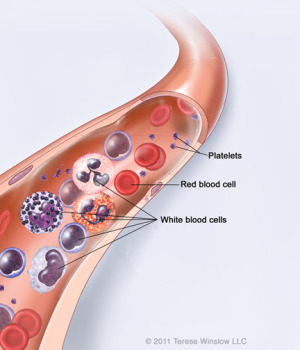Diagnosing Acute Lymphoblastic Leukemia (ALL)
 To diagnose leukemia, doctors perform a number of tests. Usually, doctors begin with a blood test (called a CBC, or complete blood count). Although the blood test may show leukemia cells, doctors need to examine a sample of bone marrow before confirming the exact diagnosis. This sample is obtained by performing a bone marrow aspirate, where doctors take a small amount of fluid from the bone marrow, where blood cells are made. Then they examine the fluid under a microscope to confirm the type of cancer before they begin treatment.
To diagnose leukemia, doctors perform a number of tests. Usually, doctors begin with a blood test (called a CBC, or complete blood count). Although the blood test may show leukemia cells, doctors need to examine a sample of bone marrow before confirming the exact diagnosis. This sample is obtained by performing a bone marrow aspirate, where doctors take a small amount of fluid from the bone marrow, where blood cells are made. Then they examine the fluid under a microscope to confirm the type of cancer before they begin treatment.
An additional test that may be performed along with the bone marrow aspirate is a bone marrow biopsy. A bone marrow biopsy may help in making a diagnosis when there are too few cells in the aspirate sample.
Determining the Extent of Disease
Since acute lymphoblastic leukemia is a cancer of the blood, it does not have “stages” the way solid tumors do. By nature, leukemia is widespread at diagnosis, but this does not affect successful treatment. However, there are prognostic indicators for acute lymphoblastic leukemia that can predict how well a child will respond to treatment. These include the white blood cell count at the time of diagnosis, age at diagnosis, high levels of leukemia cells in the spinal fluid, certain mutations in the cells, and the response to the induction (first) cycle of chemotherapy.
In some cases, leukemia cells can also be present in the spinal fluid, which is known as Central Nervous System (CNS) disease. Doctors will perform a special test known as a spinal tap or lumbar puncture to obtain fluid that they use to examine whether the disease has spread to the spinal fluid.
In addition to being present in the bone marrow and blood, acute lymphoblastic leukemia can spread to areas that are part of the blood system, causing enlargement of organs. It can affect many sites, but the most common ones are:
- Lymph nodes (glands)
- Liver
- Spleen
- Testicles
- Central nervous system
Involvement of organs other than the CNS or testicles usually has no bearing on the type of treatment given or the chances for cure.
Causes of ALL
Researchers have been looking for causes of acute lymphoblastic leukemia for over 50 years. Many studies identified what seemed like clues at the time, but they were not confirmed in later studies. Even though one or even several studies may find a link between something and risk of acute lymphoblastic leukemia, there is scientific criteria that must be met before it can be concluded that the something really causes ALL. Researchers know that the following conditions DO NOT cause ALL:
- Electromagnetic fields, such as those from power lines and electrical appliances
- Mother’s smoking during pregnancy
- Mother’s consumption of alcohol during pregnancy
- Ultrasound (sonograms) during pregnancy
- Vitamin K given to newborns to prevent bleeding
We know that some conditions mean a child is more likely to develop leukemia. These do not cause leukemia, but they may increase the risk of developing the disease:
- Genetic Conditions: Children with some genetic syndromes are more likely to develop ALL than other children. The syndromes are Down syndrome, neurofibromatosis, Schwachman syndrome, Bloom syndrome and ataxia telangiectasia. Babies with these genetic conditions are more at risk for ALL, but these account for only a small fraction of total ALL cases. These syndromes usually require medical care, so parents would know if their child had one of them.
- Ionizing Radiation (X-rays): Early studies showed there was an increased risk of ALL when a baby was x-rayed while in its mother’s womb. Today, however, researchers believe that x-rays during pregnancy cause few, if any, cases of ALL because pregnant women are not x-rayed often and the amount of radiation used in x-rays is much, much lower than it was years ago. Children who receive x-rays to diagnose a medical condition, such as a broken bone or tooth decay are NOT at increased risk to develop ALL.
- Race and Economic Status: Researchers have noted some patterns in the occurrence of childhood ALL. Hispanic children in the U.S. are more likely than non-Hispanic Caucasian children to develop ALL. Caucasian children are more likely than African American children to develop ALL. How the occurrence of ALL in Asian-American children compared to that in other children is not known. For reasons that are not yet known, children from wealthier countries are more likely to develop ALL than children from poor countries.

 Read about Graem’s battle with ALL
Read about Graem’s battle with ALL